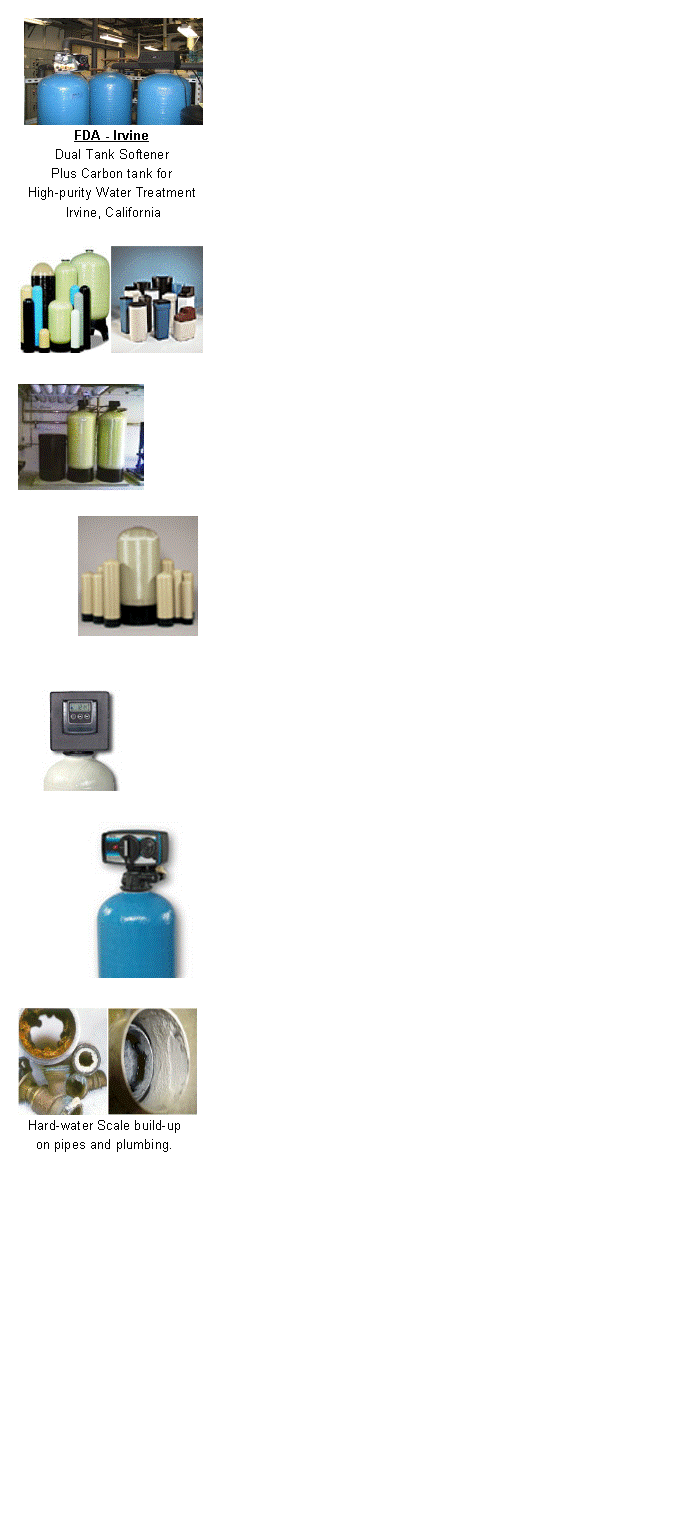Water Softeners are used to remove dissolved minerals, mainly Calcium (Ca) and Magnesium (Mg), from an incoming water source. These are the minerals that are primarily responsible for the condition that is commonly referred to as “hard water”. A water softener uses an ion exchange process to remove these minerals and the softener system will typically use a brine (salt) solution to regenerate the ion exchange resin when it becomes saturated.
Hard water is problematic because it will reduce the efficiency of heat exchange systems, such as water heaters and boilers, by creating scale on the heat transfer components of those systems. Hard water will also constrict flow through pipes, cause valves to fail, and damage the finish on plumbing fixtures, such as faucets and sinks.
An important consideration when evaluating Water Softeners is what type of Control Valve to use, Timed or Metered. For almost all applications the Metered Valve will be more efficient and cost less to operate. A metered valve will regenerate only after a specified amount of water has flown through the system. Using a Timed Valve will usually result in more frequent regeneration cycles, which will consume more salt and more water than the metered alternative.
Water Softeners – DESIGN AND OPERATION
Primary Components of Traditional Water Softener:
-
- Automatic Control Valve or Digital Controller (aka Controller)
- The most critical component of a Softener
- Controls water flow for regeneration cycles
- Mounts on top of the Resin Tank
- Typically available with Timed or Metered Regeneration
- Resin Tank
- With Control Valve mounted on top, this is the most recognizable component of a Softener
- Tank holds the resin that is used to remove dissolved solids (Ca and Mg) from water
- Cation Resin
- Cation resin in Sodium state is typically used for Softeners
- Requires regeneration with brine solution periodically to maintain softening capacity
- Brine (salt) Tank
- Brine tank is used to produce solution for regeneration of cation resin
- Salt inside brine tank is consumable for softener system
- Automatic Control Valve or Digital Controller (aka Controller)
Operation of Traditional Water Softener:
Incoming hard water flows through the Control Valve (1) and into the Resin Tank (2). Inside the tank, the Cation Resin (3) absorbs the dissolved Calcium and Magnesium. This is the process that removes the “hardness†from the water. As the dissolved minerals attach to the resin, it will gradually become “saturated”. Back-flushing with a brine solution that is produced in the Brine Tank (4) will regenerate the resin to restore the softening capacity of the system. The entire process (softening and regeneration) is controlled by the Control Valve.
Regeneration Cycles:
-
-
- Backwash with High Flow from Bottom to Top of Resin Tank
- Approx 10 minute cycle time
- Causes dirt to rise and be removed from system
- Bottom to top flow helps to “fluff” the resin
- Brine Rinse with Slow Flow from Top to Bottom of Resin Tank
- Approx 60 minute cycle time
- Increased salt level of Brine solution causes release of Ca and Mg that is attached to resin
- Brine solution with “freed” minerals is sent to drain
- Rinse with High Flow from Top to Bottom of Resin Tank
- Approx 10 minute cycle time
- Removes any excess Sodium (salt) from the Resin Tank, and “settles” resin bed
- Brine Tank Refill with Soft Water
- Approx 10 minute cycle time
- Soft water is sent to brine tank to produce brine solution for next regeneration
- Backwash with High Flow from Bottom to Top of Resin Tank
-
FYI: Softening adds approximately 80 ppm of sodium to the water during the softening process.
Water Softener System Sizing
As with any water treatment system, the first step for establishing the system requirements is to obtain a reliable water analysis. For a softener system the critical values are the parts-per-million (ppm) levels of Calcium (CA) and Magnesium (Mg) or Calcium Carbonate (CaCO3).
To determine the appropriate softener size the following formulas can be used:
Total Hardness = CaCO3 = (ppm Ca x 2.5) + (ppm Mg x 4.1)
Grains per Gallon (GPG) required = CaCO3 ÷ 17.1
Grains per Day (GPD) = Gallons of Water used per Day x GPG
Cubic Feet of Resin Required = GPD ÷ 30,000
Using this information it is possible to determine the appropriate size for a softener system. It is usually best to oversize, rather than undersize a system, and it is strongly recommended that an experienced water treatment specialist be consulted for designing and installing a water softener.
To learn more, or for assistance with your water softener project, please click here.

AquaClear, LLC Water Softener Technical Overview
